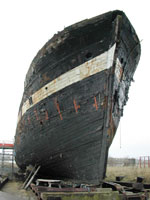
The composite clipper ship is still in Scotland but her rudder is in Australia
The rudder for the composite clipper ship, City of Adelaide, arrived in Australia the week before Christmas Typically, when a ship comes into port, the rudder arrives last. Very little has been typical, however, about the struggle to save the oldest composite clipper ship, the City of Adelaide, built in 1864.
City of Adelaide: Export row rudder arrives in Australia
Last August, we posted about news reports that the ship, which has been sitting on a Scottish slipway since 1992, had been fumigated and was waiting on a barge to take her to Rotterdam, where she would be loaded onto a container ship for her return trip to Australia. Her scheduled departure was October of 2012. The ship had previously been expected to depart the prior March, but was delayed. It turned out that virtually nothing in the news story that we posted about turned out to be accurate. As Alan Mackie was kind enough to point out to us in his comments to the post, the ship had not been fumigated and had not been loaded on a barge.
The good and also possibly bad news is that two groups are committed to saving the old ship. The City of Adelaide Preservation Trust in the ship’s namesake city was granted the right by the government of Scotland to return the ship to Australia. The Sunderland City of Adelaide Recovery Fund (SCARF) wants to return the ship to Sunderland, the city where she was built. While each group appears to be well-intentioned, neither seems to have an abundance of ready cash. The disagreement over which group can best preserve the ship has been contentious and the subject of several lawsuits.
The best estimate for the movement of the ship back to Australia is Spring of 2013.

You are right to point up the delays in CSCoAL’s removal of the City of Adelaide. There are serious questions about the viability of their project which despite the length of time the official bodies have had to liaise with their opposite numbers in Oz, have not been satisfactorily resolved.
The ship clearly needs a programme of funding comparable with those provided for the Mary Rose, the SS Great Britain and Victory. Neither SCARF or CSCoAL appear to be offering a project of the necessary scale and professional standard. CSCoAL have had at least 12 years to fund and deliver their project, and while their enthusiasm and commitment is not in doubt, there is serious doubt that they do offer the prospect of being able to offer a long term sustainable future for the ship. The fact of their unrealistic determination has lulled the relevant official bodies into a sense of false security which has hampered the development of a practical and deliverable project to secure the future of the ship.
What is necessary to save the City of Adelaide ship is a realistic, properly organised and supported project which as well as the active support of all the official bodies involved, the financial support and business acumen of some high net worth individuals, and a national appeal similar to those for the Staffordshire Hoard or the Crosby Garret helmet.
Let us hope that common sense prevails before the ship simply falls apart from delay and neglect.
I took this picture of part of Adelaide’s rudder in 2010 at the Scottish Maritime Museum, Irvine. The rudder is now safely back in Australia!
https://fbcdn-sphotos-g-a.akamaihd.net/hphotos-ak-prn2/1120041_10200840780396470_277165057_o.jpg